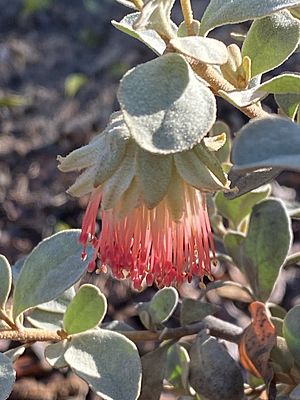Diplolaena mollis facts for kids
Quick facts for kids Diplolaena mollis |
|
|---|---|
 |
|
| 'Diplolaena mollis flower & foliage | |
| Scientific classification | |
| Kingdom: | |
| (unranked): | |
| (unranked): | |
| (unranked): | |
| Order: | |
| Family: | |
| Genus: |
Diplolaena
|
| Species: |
D. mollis
|
| Binomial name | |
| Diplolaena mollis Paul G.Wilson
|
|
Diplolaena mollis is a beautiful flowering plant. It belongs to the Rutaceae family, which also includes citrus fruits. This plant is special because it only grows in one place: the west coast of Western Australia. It has thick, egg-shaped leaves covered in soft hairs. Its flowers are reddish and hang downwards, like little bells.
What it Looks Like
Diplolaena mollis is a type of shrub. It can grow up to 2 meters (about 6.5 feet) tall. Its leaves are broad and shaped like an egg. They are usually 1 to 2 centimeters long. The leaves feel leathery and are covered in soft, light tan hairs. These hairs are shaped like tiny stars. Each leaf sits on a small stem called a petiole, which is about 3 to 6 millimeters long.
The flowers are about 1.5 to 2 centimeters wide. They have special leaf-like parts called bracts around them. The outer bracts are oval-shaped and pointed. They are 6 to 10 millimeters long and covered in soft, star-shaped hairs. The inner bracts are a bit longer and thinner.
The petals of the flowers are pale red. They are about 7 millimeters long. Some petals have woolly, star-shaped hairs. The stamens, which are the parts that hold pollen, are 1.5 to 2 centimeters long. They are pale to dark red. These stamens also have soft, star-shaped hairs near their base. Diplolaena mollis usually flowers between May and September.
How it was Named
This plant was officially named in 1998. It was described by a scientist named Paul G. Wilson. He published his description in a science journal called Nuytsia. When a plant is "formally described," it means scientists have given it a proper name and written down all its features.
Where it Grows
Diplolaena mollis is found only along the central west coast of Western Australia. You can find it north of a city called Geraldton. It also grows as far north as Shark Bay. This plant likes to grow in scrubland areas. It prefers sandy soil that is found over limestone rock.

